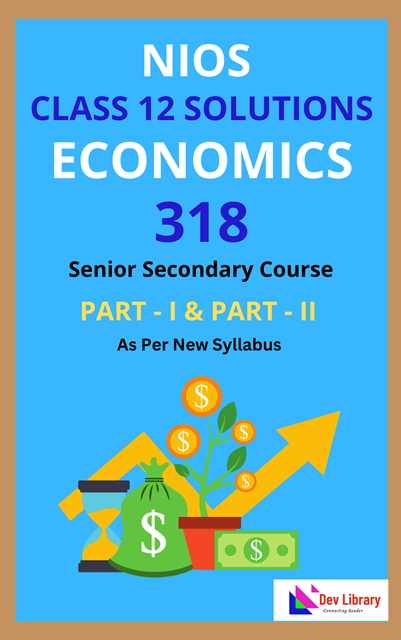NIOS Class 12 Economics Chapter 16 Price Elasticity of Demand, Solutions to each chapter is provided in the list so that you can easily browse through different chapters NIOS Class 12 Economics Chapter 16 Price Elasticity of Demand and select need one. NIOS Class 12 Economics Chapter 16 Price Elasticity of Demand Question Answers Download PDF. NIOS Study Material of Class 12 Economics Notes Paper 318.
NIOS Class 12 Economics Chapter 16 Price Elasticity of Demand
Also, you can read the NIOS book online in these sections Solutions by Expert Teachers as per National Institute of Open Schooling (NIOS) Book guidelines. These solutions are part of NIOS All Subject Solutions. Here we have given NIOS Class 12 Economics Chapter 16 Price Elasticity of Demand, NIOS Senior Secondary Course Economics Solutions for All Chapters, You can practice these here.
Price Elasticity of Demand
Chapter: 16
Module – VI: Consumer’s Behaviour
TEXT BOOK QUESTIONS WITH ANSWERS
INTEXT QUESTIONS 16.1.
Q.1. Define the following:
(i) Price elasticity of demand.
Ans. Price elasticity of demand: Price elasticity of demand means degree of responsiveness of demand for a commodity to the change in its price. For example, if demand for a commodity rises by 10% due to 5% fall in its price,
Price elasticity of demand (eₚ) = Percentage change in quantity demanded/ Percentage change in price of the commodity
= 10/(-)5 = (-)2
Note that eₚ will always be negative due to inverse relationship of price and quantity demanded.
(ii) Income elasticity of demand.
Ans. Income elasticity of demand: Income elasticity of demand refers to the degree of responsiveness of demand for a commodity to the change in income of its buyer. Suppose, income of buyer rises by 10 % and his demand for a commodity rises by 20%, then,
Income elasticity of demand (ey) = % change in quantity demanded/ % change in price of the commodity
= 20/10 = 2
(iii) Cross elasticity of demand.
Ans. Cross Elasticity of demand: Cross elasticity of demand means the degree of responsiveness of demand for a commodity to the change in price of its related goods (substitute goods or complementary goods). Suppose, demand for a commodity rises by 10% due to 5% rise in price of its substitute good, then Cross elasticity of demand (ec) = % change in quantity demanded tog/ % change in price of related good = 10/5 = 2
(Tastes and preferences cannot be expressed numerically. So elasticity of demand cannot be numerically expressed.)
Q.2. When the demand for a commodity is called elastic?
Ans. The demand for a commodity is called perfectly elastic demand when the percentage change in demand expands or contracts to any extent with the change in the price of a product, the numerical value of perfectly elastic demand is one. (Ed = ∞)
Q.3. What is the likely shape of the demand curve when the demand for a commodity is unitary elastic?
Ans. When the demand for a commodity is unitary elastic, the shape of the demand curve is expected to be a rectangular hyperbola.c
INTEXT QUESTIONS 16.2.
Q.1. Due to 5% fall in price of a commodity its demand rises by 7.5%. Calculate and state coefficient of price elasticity of demand. Whether the demand is elastic or inelastic?
Ans. Coefficient of Price elasticity of demand = Percentage of demand change/ Percentage of fall in price
= 7.5%/5%
= 1.5%
The demand is elastic.
Q. 2. Write formula for measuring price elasticity of demand at a point on a straight line demand curve.
Ans. Ed = lower segment of demand curve/ upper segment of demand curve.
Q.3. The total expenditure on a commodity falls when its price rises. Comment on the price elasticity of demand of the commodity.
Ans. The demand for the commodity will be more than unit elastic since price and total expenditure move in opposite direction.
Q.4. State any two factors which may affect price elasticity of demand for a commodity.
Ans. There are two factors affect price elasticity of demand for a commodity are:
(i) Nature of the need satisfaction: The nature of the need that the commodity satisfies also has a considerable influence on the price elasticity magnitude. In general, luxury goods are price elastic while necessities are price inelastic.
(ii) Proportion of income spent on the product: If the amount spent on a product constitutes a very small fraction of the income spent on all goods and services consumed, then the price elasticity is likely to be small. On the other hand, if a product takes a major portion of income, demand for it tends to be more sensitive to a price change, that is the elasticity of demand is likely to be high.
Q.5. Why is the demand for water inelastic?
Ans. Water is necessity and its consumption will not change with rise or face in price.
TERMINAL EXERCISE
Q.1. Draw diagrams for:
(i) Perfectly elastic demand.
Ans. Perfectly inelastic demand: Whatever may be the change in the price, the quantity demanded remains the same.
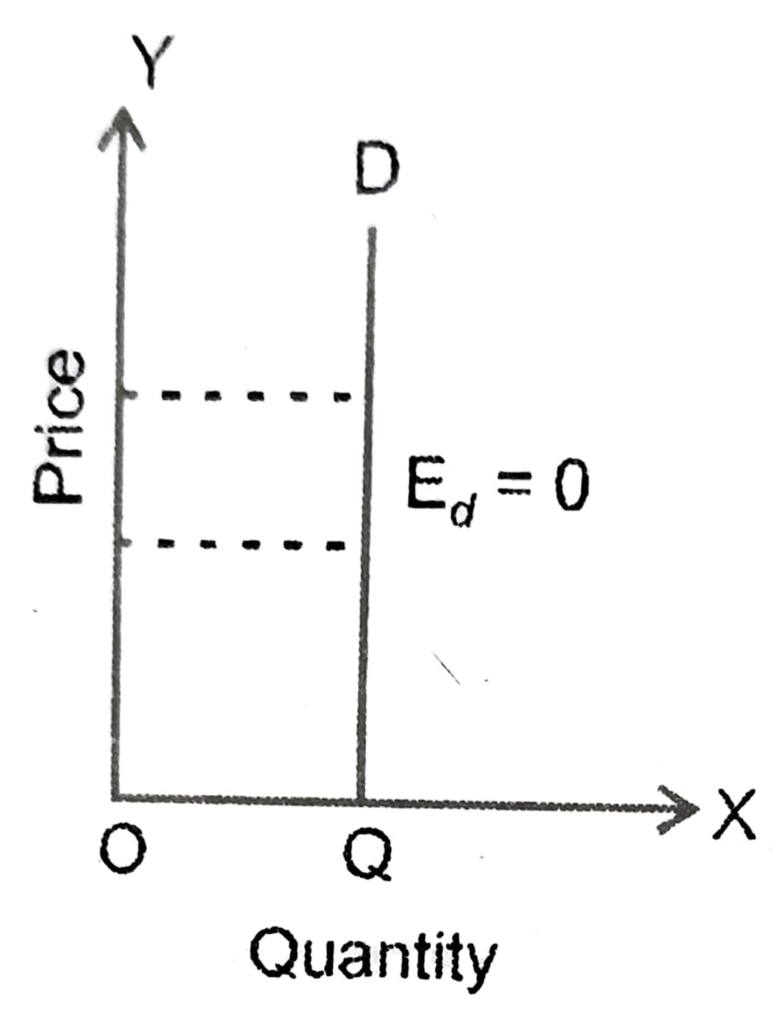
(ii) Perfectly inelastic demand.
Ans. Perfectly elastic demand: Any amount can be demanded at a given price but if the price changes slightly, the good is not demanded at all.
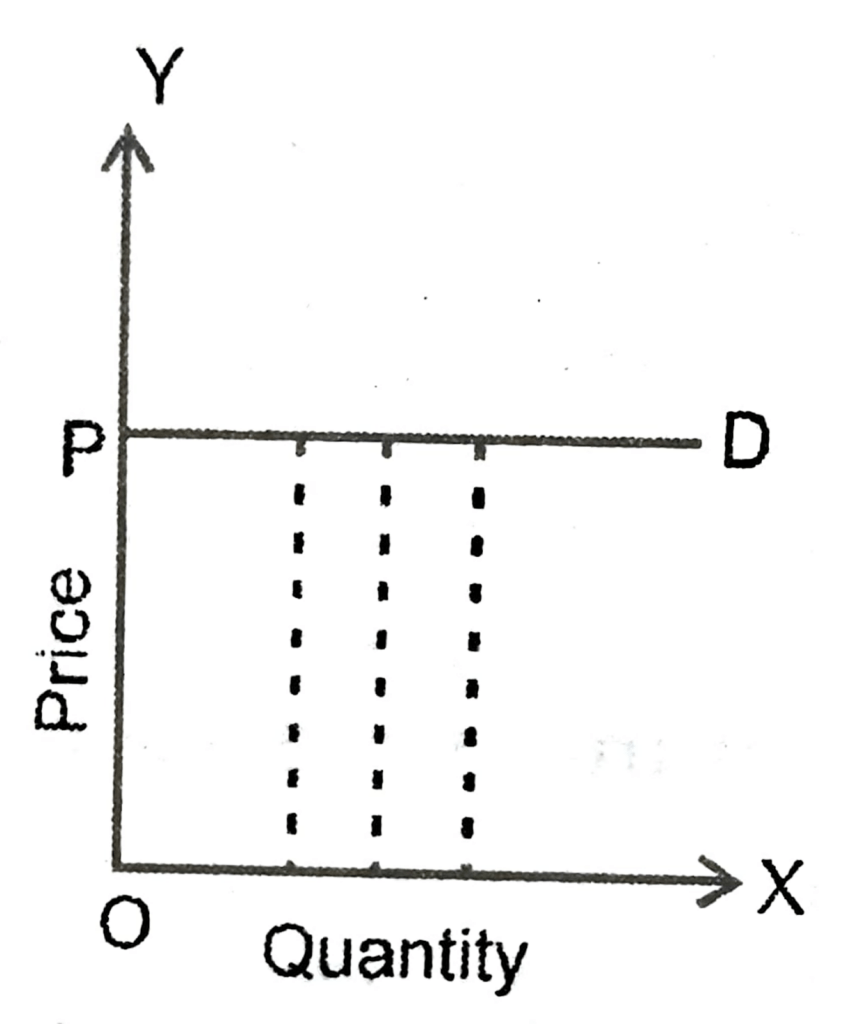
(iii) Unit elastic demand.
Ans. Unitary elastic demand: In this case, the percentage change in quantity is equal to the percentage change in price.

Q.2. Prepare a schedule for-
(i) More than unit elastic demand.
Ans. More than unit elastic demand
| Price (₹ per unit) | Quantity demanded (in units) | Total expenditure (in ₹) |
| 24 | 100 | 2400 |
| 20 | 140 | 2800 |
| 16 | 200 | 3200 |
(ii) less than unit elastic demand.
Ans. Less than unit elastic demand
| Price (₹ per unit) | Quantity demanded (in units) | Total expenditure (in ₹) |
| 24 | 100 | 2400 |
| 20 | 110 | 2200 |
| 16 | 120 | 1920 |
Q.3. Explain percentage change method of measuring price elasticity of demand.
Ans. This method is called ‘Proportionate method or flux method’. According to this method price elasticity of demand is measured as a ratio of percentage change in quantity demanded to the percentage change in price of the commodity.
Price elasticity of demand (Ed)
= Percentage change in quantity demanded / Percentage change in price of the commodity
Percentage change in quantity demanded
= Change in quantity (∆Q) / Initial quantity(Q) x 100
Percentage change in price
= Change in price (∆P) / Initial price (P) x 100

Where
∆Q = Change in quantity demanded
Q = Initial quantity demanded
∆P = Change in price
P = Initial price
Q.4. Explain the relationship between total expenditure incurred on a commodity and its price elasticity of demand.
Ans. According to total expenditure method the relationship between price elasticity and total expenditure may be put as under:
(i) When a fall or rise in price does not cause any change in total expenditure on the commodity, elasticity of demand is unity. (Ed = 1)
(ii) When a fall in price leads to increase in total expenditure or rise in price reduces total.expenditure, elasticity of demand is more than unity (Ed > 1).
(iii) When a fall in price reduces total expenditure or rise in price increase total expenditure, elasticity of demand is less than unity (Ed < 1).
Q.5. How is Price elasticity of demand of a commodity affected by availability of its cross substitute? Explain.
Ans. Demand for a commodity with large number of substitutes will be more elastic. The reason is than even a small rise in its prices will induce the buyers to go for its substitutes. For example, a rise in the price of pepsi encourages buyers to cope and vice-versa.
Thus, availability of close substitutes makes the demand sensitive to change in the prices. On the other hand, commodities with few or no substitutes like wheat and salt have less price elasticity of demand.
Q.6. A household purchases 40 units of a good when its price is Re. 1 per unit. At what price he would purchase 36 units of it if coefficient of price elasticity of demand is unitary.
Ans. Q = Initial quantity demanded = 40 units.
Q₁ = New quantity demanded = 36 units.
P = Initial price = ₹ 1 per unit.
P₁ = New Price = Suppose x elasticity of demand is 1.
Percentage change in quantity demanded
= – 4/40 x 100 = 10
Percentage change in price = 1 – x/1 x 100 = 100 – 100x
= 1 = 10/ 100 – 100x
= 9x = 1
= x = 1/9 = 1.1
At ₹ 1.1 he would purchase 36 units.
Q.7. What quantity of a commodity would a household purchase at a price of ₹ 12 per unit, if he purchases 40 units of it at ₹ 10 per unit? Price elasticity of demand is (-)1.5.
Ans. Q = Initial quantity demanded = 40 units.
Q₁ = New quantity dem anded = x units.
P = Initial price = ₹ 10 per unit.
P₁ = New price = ₹ 12 per unit.
Elasticity of demand is -1.5
Percentage change in quantity demanded
= 40 – x/40 × 100
= 200 – 5x/2
Percentage change in price = 2/10 x 100 = 20
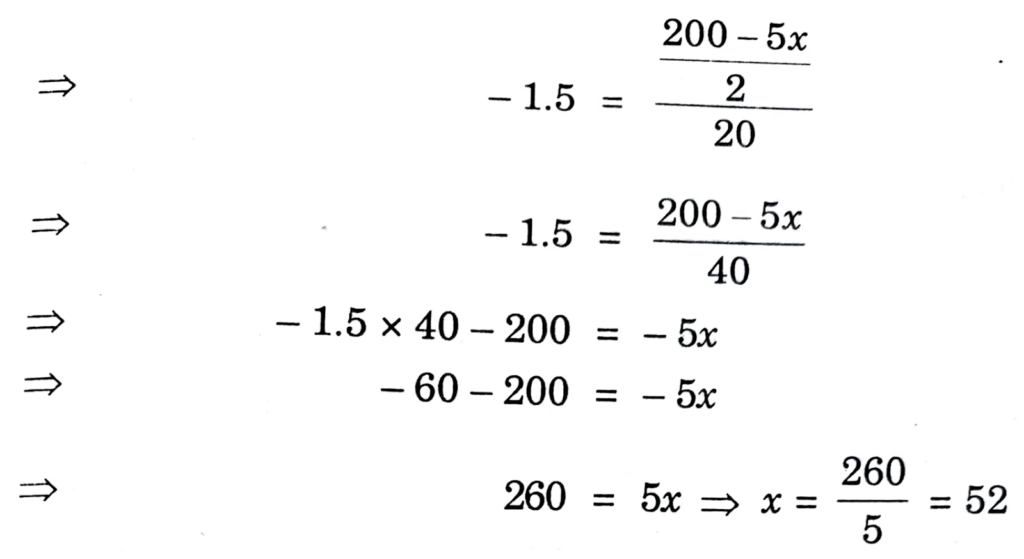
The household buys 52 units at a price of ₹ 12 per unit.
Q.8. A household spends ₹ 120 on purchase of a commodity when its price is ₹ 6 per unit. When price rises to ₹ 10 per unit, his total expenditure on this commodity becomes ₹ 180. Calculate price elasticity of demand by percentage change method.
Ans. Price elasticity of demand (Ed) = Percentage change in quantity demanded/ Percentage change in price of the commodity.
Q = Initial quantity demanded
= 120/6 = 20 units
Q₁ = New quantity demanded = 180/10 = 18 units
P = Initial price = ₹ 6 unit
P₁ New price = ₹ 10 per unit
Percentage change in quantity demanded.
= 2/20 x 100 = 20%
Percentage change in price = 4/10 x 100 = 40%
Price elasticity of demanded (Ed) = 20/40 = 0.5
Q.9. When price of a commodity falls from ₹ 20 per unit to ₹ 16 per unit, its quantity demanded increases by 20%. Calculate coefficient of price elasticity of demand.
Ans. Percentage change in Quantity demanded = 20%
P = Initial Price = Rs. 20 per unit.
P₁ = New Price = Rs. 16 per unit.
Percentage change in price
= 20/40 x 100 = 20%
Price elasticity of demand (Ed)
= 20/20 = 1.
Q.10. A consumer buys 15 units of a good at a price of ₹ 10 per unit. At price ₹ 15 per unit he buys 10 units. What is price elasticity of demand? Use expenditure approach. Comment on the likely shape of demand curve on the basis of this measure of elasticity.
Ans. Price elasticity of demand (Ed) = percentage change in quantity demanded/percentage change in price of the commodity
Q = Initial Quantity demanded = 15 units.
Q₁ = New Quantity demanded = 10 units.
P = Initial Price = Rs. 10 per unit.
P₁ = New Price = Rs. 15 per unit.
Percentage change in quantity demanded = 5 / 15 x 100 = 33%
Percentage change in quantity demanded = 5 / 15 x 100 = 33%
Percentage change in price = 5 / 10 x 100 = 50%
Price elasticity of demand (Ed) = 33 / 50 = 0.66
Graphically, demand curve is steeper in this elasticity of demand.
Some Other Important Questions For Examinations
Very Short Answer Type Questions
Q.1. Explain any four factors affecting the price elasticity of demand.
Ans. Four factors affecting the price elasticity of demand: Following factors affect the price elasticity of demand:
(i) Availability of close substitute: If close substitutes of a product are readily available, its price elasticity of demand is likely to be high because even a very small increase in price will make consumer switch to other products in a big way. Otherwise, in the absence of close substitutes, the elasticity is likely to be small.
(ii) Nature of the need satisfaction: The nature of the need that the commodity satisfies also has a considerable influence on the price elasticity magnitude. In general, luxury goods are price elastic while necessities are price inelastic.
(iii) Proportion of income spent on the product: If the amount spent on a product constitutes a very small fraction of the income spent on all goods and services consumed, then the price elasticity is likely to be small. On the other hand, if a product takes a major portion of income, demand for it tends to be more sensitive to a price change, that is the elasticity of demand is likely to be high.
(iv) Number of uses to which a commodity can be put: The more possible uses of a commodity, the greater will be its price elasticity.
Q.2. How does the nature of a commodity influence the price elasticity of.demand?
Ans. A commodity has different nature for different persons. It may be a necessary, it may be a comfort. It may be a luxury.
1. The demand for a good is generally inelastic if it is a necessary.
2. The demand for a good is generally elastic if it is a comfort.
3. The demand for a good in generally more elastic if it is a luxury.
Q.3. How is the price elasticity of demand for a commodity affected by the number of its substitute? Explain.
Ans. If close substitutes of a product are readily available, its price elasticity of demand is likely to high because even a very small increase in price will make consumer switch to other products in a big way. Otherwise, in the absence of close substitutes the elasticity is likely to be small.
Q.4. Explain any three factors that affect price elasticity of demand.
Ans. Three factors affecting price elasticity of demand: Many factors affect price elasticity of demand. Three of them have been explained below.
(i) Availability of close substitute: If close substitutes of a product are readily available, its price elasticity of demand is likely to be high because even a very small increase in price will make consumer switch to other products in a big way. Otherwise, in the absence of close substitutes, the elasticity is likely to be small.
(ii) Nature of the need satisfaction: The nature of the need that the commodity satisfies also has a considerable influence on the price elasticity magnitude. In general, luxury goods are price elastic while necessities are price inelastic.
(iii) Proportion of income spent on the product: If the amount spent on a product constitutes a very small fraction of the income spent on all goods and services consumed, then the price elasticity is likely to be small. On the other hand, if a product takes a major portion of income, demand for it tends to be more sensitive to a price change, that is the elasticity of demand is likely to be high.
Short Answer Type Questions
Q.1. Explain the geometric method of measuring price elasticity of demand.
Ans. Elasticity of demand may be different at different points along the same demand curve. It, therefore, becomes necessary to measure the elasticity of demand at a particular point on a demand curve. This is done through geometrical method. In order to find out the elasticity of demand through this method, we may first expand the straight line demand curve to the x- axis and y-axis. The point at which we want to calculate the elasticity of demand divides the demand curve into two parts: lower sector and the upper sector. Now to calculate the elasticity of demand, we divide the lower sector by its upper sector.
ED = Lower Sector / Upper Sector
This is explained in the following diagram: Elasticity at point R on the MN straight line demand curve will be, as shown in diagram.

eD = RN (Lower Sector) / MR (Upper Sector)
Different elasticities at different points of a demand curve: This method tells us that a downward sloping demand curve has different elasticities at its different points. This is shown in the diagram.
In the diagram, MN is a downward sloping demand curve joining the two axis and R is the mid-point on this curve. Now the elasticities at different points would be as follows:
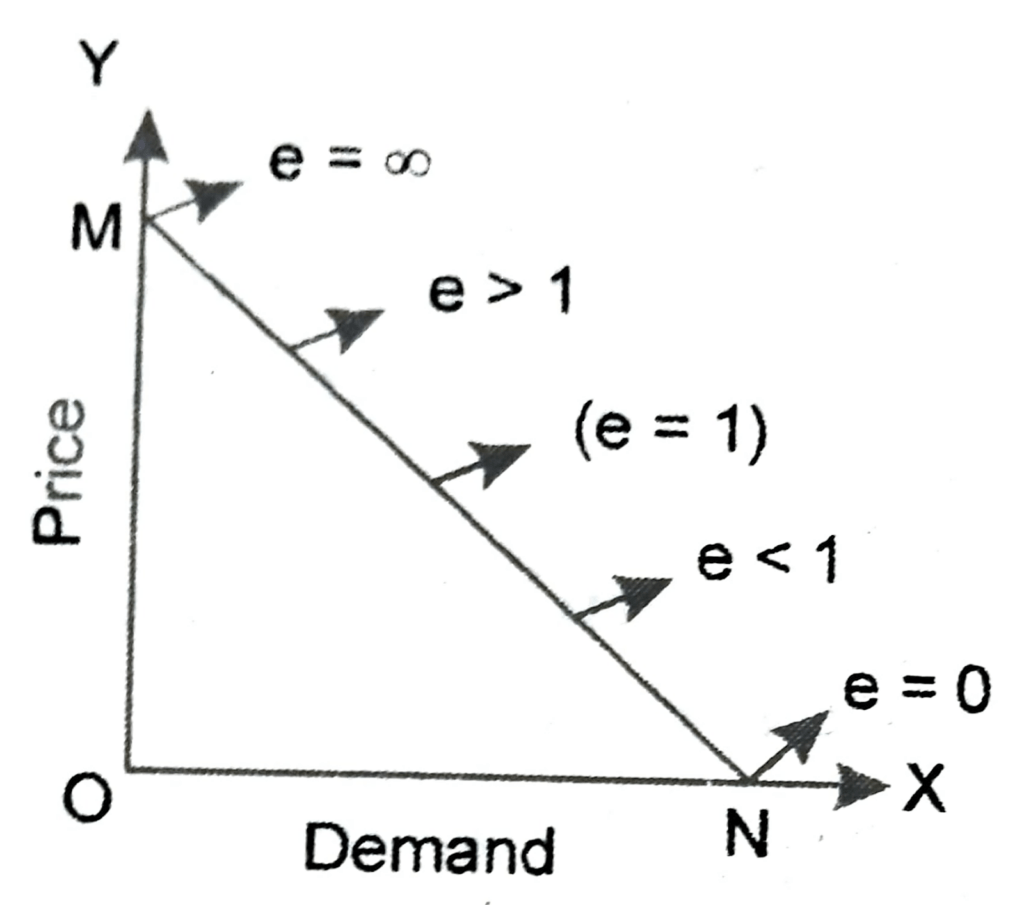
(i) At the midpoint of the curve (R) elasticity of demand would be unity (eD = 1).
(ii) At any point above midpoint, the elasticity would be greater than one (eD = 1).
(iii) At the point where the demand curve meets the y-axis, the elasticity would be infinity (eD = ∞).
(iv) At any point below the midpoint, the elasticity would be less than one (eD < 1).
(v) At the point where the demand curve meets the x-axis, the elasticity would be zero (eD = 0).
In short, on a straight line demand curve above the midpoint, demand is elastic, below it, jualelastic and as it, it is unitary elastic.
Q.2. Price of a product falls from ₹ 10 to ₹ 9 per unit. As a result its demand rises from 9 units to 10 units. Calculate price elasticity of demand using expenditure approach.
Ans.
| Price | Demand | Expenditure |
| 10 | 9 | 90 |
| 9 | 10 | 90 |
Since with change in price total expenditure remains unchanged, Eₚ is (-) 1.
Q.3. Price of a good rises from ₹ 7 per unit to ₹ 9 per unit but its demand remains unchanged. Calculate price elasticity of demand of the good.
Ans. Price elasticity of demand = 0
This is because with the change in price there is no change in quantity demanded. Hence the demand is perfectly inelastic.
Q.4. What is the price elasticity of demand? How is it different from price effect?
Ans. Price Elasticity of Demand: By price elasticity of demand, we mean the degree of responsiveness of demand to change in price. In simple terms, it is a measure of responsive-ness of demand to change in price. Law of demand states that with the increase in price, there is fall in demand and vice versa. But it does not tell us the degree of change that takes place in demand with a change in price. It is elasticity of demand which tells us the degree of change that takes place in demand with the change in price. According to Prof Boulding, “The elasticity of demand measures the response of the change in commodity demanded to change in price.”
Price elasticity of demand nay be defined as the percentage change in the quantity demanded due to percentage change in the price of the commodity. The formula for measuring elasticity of demand may be written as under:
Price elasticity of demand =
Percentage change in quantity demanded/ Percentage change in the price of the commodity
Or

Difference between price elasticity of demand and price effect: Under price elasticity of demand, we measure the relative or proportional change in the quantity demanded and the price. On the other hand, we measure the absolute change in price and the quantity demand of a commodity under price effect.
Q.5. Price elasticity of demand of a good is (-) 4. When price of the good falls, its demand rises by 24%. Calculate percentage change in price.
Ans. Ed = % change in quantity demanded/ % change in price
(-) 4 = 24/ % change in price
Percentage change in price = (-)6
(-) sign shows that the price is falling.
Q.6. Price of a good rises by 25% but there is no effect on demand of the good due to this price. Calculate price elasticity of demand.
Ans. When price of good rises by 25% but there is no effect on demand of the good due to change in price, the price elasticity of demand will be zero (0) i.e. perfectly inelastic.
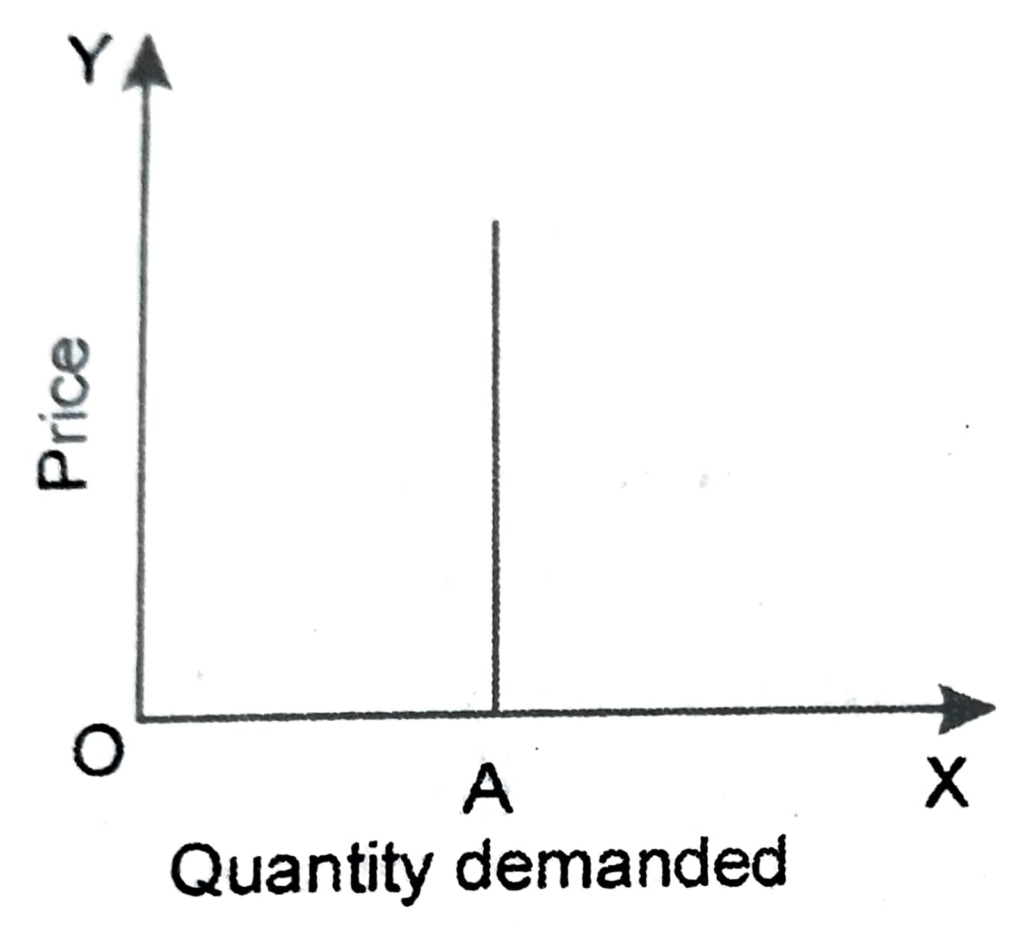
Q.7. Draw a straight line demand curve and show on it a point at which:
(i) Price elasticity of demand > 1
(ii) Price elasticity of demand < 1
(iii) Price elasticity of demand = 1
Ans. In following figure:

B-midpoint on demand curve DD₁.
(i) Price elasticity of demand at point

Q.8. Explain the total outlay method of measuring price elasticity of demand.
Ans. Total outlay method (Unitary expenditure method): In the total outlay method, price elasticity of demand is measured by comparing the total expenditure of the consumer on a commodity before and after a change in its price. According to this method, elasticity may be equal to unity, greater than unity or less than unity.
1. Elasticity equal to one (e = 1): When change in price of a commodity does not bring about any change in the total outlay, then elasticity of demand is equal to one. It has been explained with the help of the following table:
| Price (₹) | Quantity Demand (Units) | Total Expenditure (₹) |
| 5 | 4 | 20 |
| 4 | 5 | 20 |
2. Elasticity more than one (e >1): If the rise in price leads to decrease in the total outlay and vice versa, then price elasticity is more than one or unit. It has been explained with the help of the following table:

2. Less than one (e <1): If the rise in price leads to increase in the total outlay and vice versa then price elasticity is less than one or unit. It has been explained with the help of the following table:
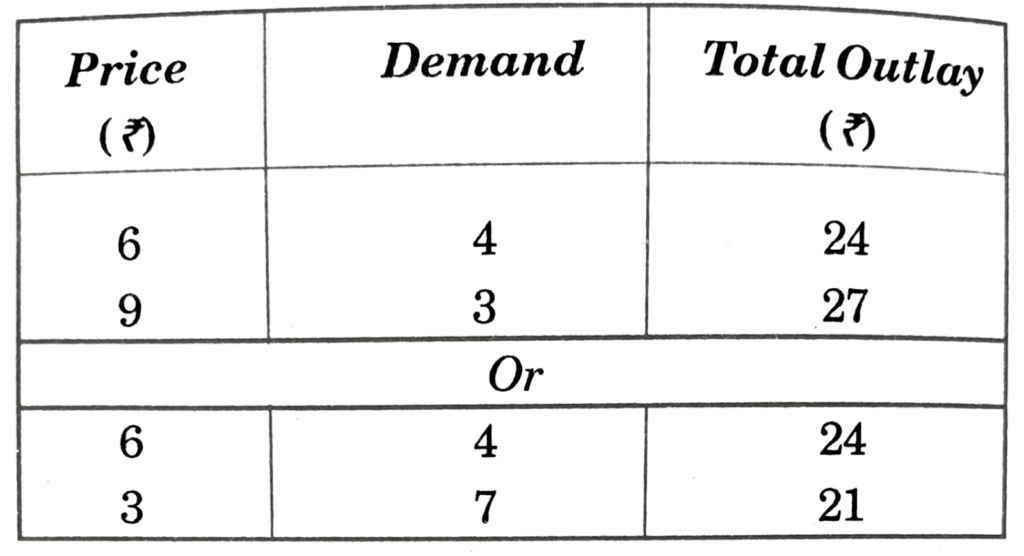

Hi! my Name is Parimal Roy. I have completed my Bachelor’s degree in Philosophy (B.A.) from Silapathar General College. Currently, I am working as an HR Manager at Dev Library. It is a website that provides study materials for students from Class 3 to 12, including SCERT and NCERT notes. It also offers resources for BA, B.Com, B.Sc, and Computer Science, along with postgraduate notes. Besides study materials, the website has novels, eBooks, health and finance articles, biographies, quotes, and more.


